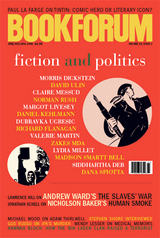
If two mirrors are turned face-to-face, each will reflect the other’s reflection of itself, and so on. Thus is generated (at least in theory) an image that resembles a tunnel going on forever—albeit to nowhere in particular. In practice, of course, there are limits to just how far this regress reaches. The mirrors have to be absolutely parallel, and any distortions on their surfaces ruin the effect. But even a glimpse of this virtual abyss can be sublime. Either that or queasy-making.
Precisely that range of affective response was common in the early days of what François Cusset calls French Theory. (That term subsumes everyone from Althusser to ´i¸ek.) The labors of an inexhaustible perspectivism—the patient yet manic picking apart of established structures of thought—opened up an abyss that could induce exaltation and/or nausea. But with time, theory was assimilated, domesticated, even (to a degree) commercialized. The void could be contemplated with comfort and convenience, as from a grand hotel perched on its edge.
Cusset’s study treats the by now familiar saga of America’s romance with the perspectivist boom in continental theory as a fresh interpretive challenge. He defamiliarizes the situation through a canny reframing of things—one that proves almost vertiginously en abyme. This approach has the salutary effect of grinding down and dissolving the tendency to deduce from a fait accompli that there was some intrinsic affinity between a particular body of French thinkers and certain American academics.
The guiding question in Cusset’s book is, How did it come to pass that a group of French intellectuals who were seldom closely affiliated, pursued radically incompatible lines of thought, and were often quite passé at home turned by the mid-1980s into hotly coveted exports for the American intellectual market? Indeed, these thinkers were transformed into something like the various models of a single brand—repackaged, cross-promoted, and vended with the steep discounts made possible through economies of scale.
But scarcely any of this process was deliberate. The speed and efficiency with which it operated were the effects, not of conscious intention, but of an almost rhizomatic growth that Cusset understands (contra the familiar saga of the rise of “tenured radicals”) as extending far beyond the university itself. To be sure, Cusset provides a serviceable map of the world of professorial superstardom through sketches of the careers of Gayatri Spivak, Paul de Man, Edward Said, and so on. And he summarizes all those terribly exciting debates from yesteryear regarding multiculturalism, political correctness, and the Sokal hoax.
The heart of the narrative is elsewhere, though. A chapter on “The Seventies” gathers up the scattered anecdotes about how various French thinkers made connections with the American counterculture, such as the interest of Tel Quel in Allen Ginsberg, visits by Deleuze and Guattari with the Black Panthers and Patti Smith, and numerous other cross-marginal encounters. Later sections treat the migration of poststructuralist concepts, or at least buzzwords, into the world of artistic practice of the 80s (the profitable misunderstandings between Baudrillard and neo-geo, for example) and the emergent cybersphere a little later.
Such wide-angle coverage makes for something considerably richer and more welcome than another book revisiting questions of “the can(n)on”—for Cusset is alert to the extreme heterogeneity both of theory and of the cultural landscape over which it spread. This in turn encourages him to focus on the small-scale mechanisms that helped constitute French Theory as an identifiable commodity, such as Duke’s Post-Contemporary Interventions series and the Foreign Agents booklets from Semiotext(e). Such venues worked “to create an impression of intellectual promiscuity between the texts and authors that were brought together in the same series or in the same collection,” writes Cusset.
That is only the most tangible level of the process. More powerful, and with stronger reflexive consequences, is the act of quotation—understood not simply as a vector for dispersing particular ideas but as the definitive gesture of the American theoretical imagination itself. Certain familiar refrains (“incredulity regarding metanarratives,” “there is no outside-the-text,” etc.) constitute what Cusset terms
a floating space, a transdiscursive zone traversed by proper names and passing concepts, in which quotations can escape from both the quoted and the quoter, and in which the French loan loses its distinction from the American addendum. . . . The internal order of such a discourse has more to do with rhythm than with linear argument, and with the charisma of a name-of-the-concept than with its explication.
This description applies to the North American zone of conceptual free trade far more than it does to the master thinkers themselves, who tended to be rather less laissez-faire. “The very logic of French theoretical texts prohibits certain uses of them,” writes Cusset, “uses that were often necessary, however, to their American readers in order to put the texts to work.” He cites the example of an audience at NYU that wanted Foucault to move from theorizing about “the ethics of the self” to providing a method. “The last thing I want to tell you,” he is said to have responded, “is how to live!”
One might well reread this book with a deconstructive eye, to interrogate a whole series of binary oppositions structuring its logic: French theoreticism and cultural hierarchy, perhaps, versus American pragmatism and the spirit of independent trucking—but the elegance and power of Cusset’s work are largely the product of his willingness to keep either side from assuming a position of unquestioned dominance. Cusset analyzes cultural theory within its cultural matrix without disappearing into an abyss along the way. Easier said than done, but French Theory manages the trick, sometimes brilliantly.
Scott McLemee wrote the introduction to Framing Theory’s Empire (Parlor Press, 2007).
